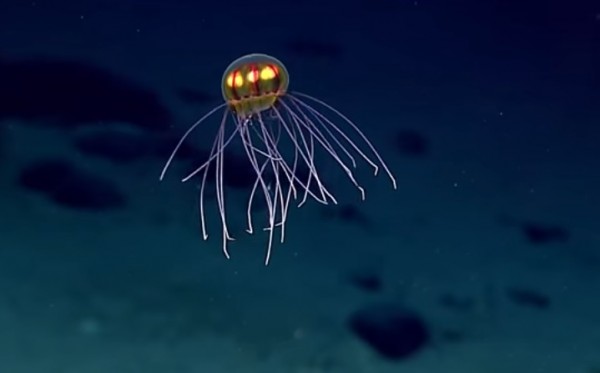By Ana Verayo, | May 03, 2016

Rare marine species such as this hydromedusa belonging to the genus Crossota are in danger of disappearing due to warming ocean temperatures.
A newly discovered deep sea jellyfish appears to be an alien spacecraft according to marine biologists, than a marine creature.
A team of scientists from the National Oceanic and Atmospheric Administration (NOAA) spotted this bizarre, glowing creature that involves bio luminescent lights in red and yellow, found inside its body. Using the Deep Discoverer, which is a remotely operated vehicle (ROV), the team was exploring the Marianas Trench in the western pacific Ocean near Southeast Asia, when they captured the ethereal creature on video.
Like Us on Facebook
This newly found jellyfish species is believed to be a hydromedusa belonging under the genus Crossota, possessing long and short tentacles that extend from its bell shaped body. In this video, the cnidrian exposes and protrudes its long tentacles when its gelatinous body does not show any movement. Scientists suggest that the creature sensed the ROV's presence, prompting it to be on ambush predator mode.
More interestingly, the lights that emanate from inside its bell-like gelatinous body possess radial canals of red which connects to the gonads, seen in glowing yellow lights.
The alien spaceship looking jellyfish was first spotted last April 24 during the the 2016 Deepwater Exploration of the Marianas, reaching depths of 12,140 feet or 2.3 miles. This deep sea expedition is part of NOAA's program to further understand deep sea marine biodiversity and ecosystems.
Apart from this glowing, ethereal creature, the dive also revealed the spectacular features of the trench, specifically the Enigma Seamount. NOAA scientists say that the morphology of this feature is so distinct from other seamounts in the region, where most consist of a flat top and steep, smooth sides that extends into narrow ridges. This one however, is more circular in shape and the sides are less smooth.
During this dive, the ROV obtained some several rock specimens in which one sample appeared to be volcanic in origin but seemed to consist of pebble-like material, that suggests that it was formed by the movement of currents. There are also tiny, spherical organic balls that are found by researchers that could be single celled amoebas.
The first leg of this dive is expected to be completed by May 11, and the second and third legs will follow on May 20 and June 17.
-
Use of Coronavirus Pandemic Drones Raises Privacy Concerns: Drones Spread Fear, Local Officials Say

-
Coronavirus Hampers The Delivery Of Lockheed Martin F-35 Stealth Fighters For 2020

-
Instagram Speeds Up Plans to Add Account Memorialization Feature Due to COVID-19 Deaths

-
NASA: Perseverance Plans to Bring 'Mars Rock' to Earth in 2031

-
600 Dead And 3,000 In The Hospital as Iranians Believed Drinking High-Concentrations of Alcohol Can Cure The Coronavirus

-
600 Dead And 3,000 In The Hospital as Iranians Believed Drinking High-Concentrations of Alcohol Can Cure The Coronavirus

-
COVID-19: Doctors, Nurses Use Virtual Reality to Learn New Skills in Treating Coronavirus Patients







